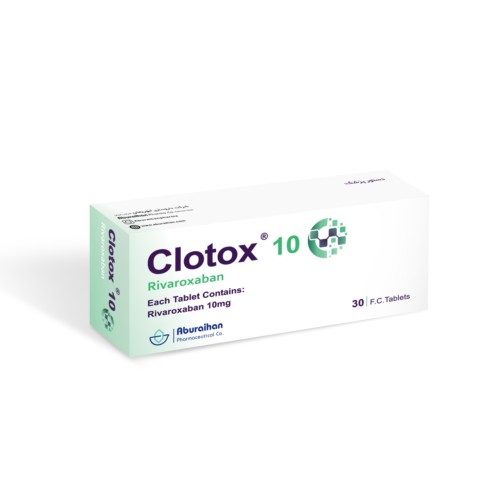Clotox ®
Rivaroxaban
Tablet
10, 15 & 20 mg
Deep vein thrombosis
Pulmonary embolism
Nonvalvular atrial fibrillation
Postoperative venous thrombophylaxis following hip or knee replacement surgery
Mechanism of Action:
Rivaroxaban is a factor Xa inhibitor anticoagulant.
Method of Administration:
Atrial fibrillation, nonvalvular (to prevent stroke and systemic embolism):
Oral: 20 mg once daily with the evening meal.
Postpercutaneous coronary intervention with stent placement and nonvalvular atrial fibrillation (off label):
Oral: 15 mg once daily with food; administer with an appropriate antithrombotic regimen including clopidogrel (preferred P2Y12 inhibitor in this situation) with or without aspirin, depending on risk for thrombosis and bleeding, and time since percutaneous coronary intervention (PCI). It is recommended to discontinue aspirin 1 to 4 weeks after PCI and continue rivaroxaban and clopidogrel.
Venous thromboembolism:
Deep vein thrombosis and/or pulmonary embolism treatment:
Note: May be used in patients with active cancer (eg, metastatic disease, receiving chemotherapy); however, avoid use in patients with upper GI tract cancers due to increased bleeding risk.
Oral: 15 mg twice daily with food for 21 days followed by 20 mg once daily with food.
Venous thromboembolism prophylaxis:
Acutely ill medical patients:
Oral: 10 mg once daily for a total duration of 31 to 39 days (including hospitalization and postdischarge). Some experts prefer LMWH as prophylaxis during acute hospitalization and suggest not routinely extending prophylaxis beyond.
Nonmajor orthopedic surgery of lower limb (alternative therapy) (off-label use):
Note: Early ambulation alone is preferred when feasible, but pharmacologic prophylaxis may be considered for patients with higher than usual risk (eg, history of venous thromboembolism, limited mobility, or undergoing high risk surgery such as Achilles tendon repair, femoral fracture, tibial plateau fracture, or ligament repair of the knee).
Oral: 10 mg once daily initiated ≥6 to 10 hours after surgery; continue for the duration of immobilization.
Total hip arthroplasty or total knee arthroplasty:
Oral: 10 mg once daily initiated ≥6 to 10 hours after surgery or when hemostasis established.
Duration: Optimal duration of prophylaxis is unknown but it is usually given for a minimum of 10 to 14 days and can be extended for up to 35 days (Ref); some experts suggest a duration in the lower end of the range (10 to 14 days) for total knee arthroplasty (TKA) or higher end of range (30 days) for total hip arthroplasty (THA).
Notes
Contraindications
Active pathological bleeding, Severe hypersensitivity reaction to Rivaroxaban.
Interactions
Agents with Antiplatelet Properties (e.g., P2Y12 inhibitors, NSAIDs, SSRIs, etc.): May enhance the anticoagulant effect of Rivaroxaban. Management: Carefully consider risks and benefits of this combination and monitor closely; Canadian labeling recommends avoiding prasugrel or ticagrelor. Risk C: Monitor therapy
Anticoagulants: May enhance the anticoagulant effect of Rivaroxaban. Refer to separate drug interaction content and to full drug monograph content regarding use of rivaroxaban with vitamin K antagonists (eg, warfarin, acenocoumarol) during anticoagulant transition and bridging periods. Risk X: Avoid combination
Apixaban: May enhance the anticoagulant effect of Anticoagulants. Refer to separate drug interaction content and to full drug monograph content regarding use of apixaban with vitamin K antagonists (eg, warfarin, acenocoumarol) during anticoagulant transition and bridging periods. Risk X: Avoid combination
Aspirin: May enhance the adverse/toxic effect of Rivaroxaban. Specifically, the risk of bleeding may be increased. Management: Carefully consider risks and benefits of this combination and monitor closely. Risk D: Consider therapy modification
Clarithromycin: May increase the serum concentration of Rivaroxaban. Risk C: Monitor therapy
Deferasirox: Anticoagulants may enhance the adverse/toxic effect of Deferasirox. Specifically, the risk for GI ulceration/irritation or GI bleeding may be increased. Risk C: Monitor therapy
Nonsteroidal Anti-Inflammatory Agents (Nonselective): May enhance the adverse/toxic effect of Rivaroxaban. Specifically, the risk of bleeding may be increased. Management: A comprehensive risk to benefit assessment should be done for all patients before any concurrent use of rivaroxaban and nonsteroidal anti-inflammatory drugs (NSAIDs). If combined, monitor patients extra closely for signs and symptoms of bleeding. Risk D: Consider therapy modification
Pregnancy and Lactation
Rivaroxaban crosses the placenta; Use of direct acting oral anticoagulants increases the risk of bleeding in all patients. When used in pregnancy, there is also the potential for fetal bleeding or subclinical placental bleeding which may increase the risk of miscarriage, preterm delivery, fetal compromise, or stillbirth.
Rivaroxaban is present in breast milk, the decision to breastfeed during therapy should consider the risk of infant exposure, the benefits of breastfeeding to the infant, and benefits of treatment to the mother.
Warning and Precaution
- Antiphospholipid syndrome:
Use not recommended in patients with triple-positive antiphospholipid syndrome; safety and efficacy have not been established. Patients positive for all 3 antiphospholipid antibodies (lupus anticoagulant, anticardiolipin, and anti-beta 2-glycoprotein I) may have increased rates of recurrent thrombotic events compared with vitamin K antagonist therapy.
- GI/Bariatric surgery:
Altered absorption: Evaluate the risk versus benefit of possible decreased drug absorption. Rivaroxaban is significantly absorbed through the stomach. Procedures that reduce the absorptive surface area of the stomach or accelerate gastric emptying (eg, sleeve gastrectomy) may decrease bioavailability of rivaroxaban.
- Hepatic impairment: Avoid use in patients with moderate to severe hepatic impairment (Child-Pugh classes B and C) or in patients with any hepatic disease associated with coagulopathy.
- Kidney impairment: Dose adjustment is necessary for patients with kidney impairment, and specific adjustments are indication specific. Discontinue use in patients who develop acute kidney failure.
- Valvular disease: Avoid use in patients with surgically implanted mechanical heart valve, transcatheter aortic valve replacement with no other indication for anticoagulation, moderate to severe mitral stenosis, or significant rheumatic heart disease.
Adverse Reactions
>10%:
Endocrine & metabolic: Heavy menstrual bleeding (adolescents: 27%)
Gastrointestinal: Gastroenteritis (pediatric patients: 13%), vomiting (pediatric patients: 11% to 14%)
Hematologic & oncologic: Hemorrhage (pediatric patients and adults: 5% to 36%; major hemorrhage: ≤4%) (table 1)
Storage
Store below 30°C and protect from light and moisture.



